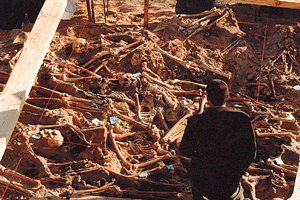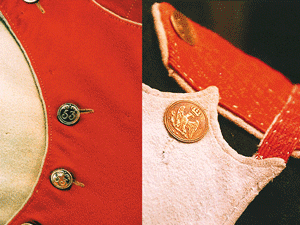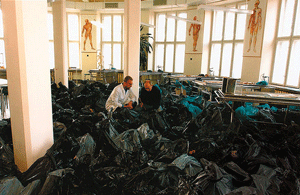
A mass grave in Lithuania stirs memories of the catastrophic French retreat from Moscow.

French scientist Michel Signoli inspects a mass grave in Lithuania containing as many as 2,000 skeletons. Study of the bones, including DNA analysis, will help determine the cause of death
(© Xavier Rossi/Gamma)
Now a prosperous, post-Soviet city, the Lithuanian capital of Vilnius has had a turbulent and often violent history. Since its founding in the mid-thirteenth century, Lithuania, and especially its capital, was often at the center of conflicts between Russia and Poland, and more recently, the Soviet Union and Germany. When a mass grave was discovered by construction workers in the Siaures Miestelis ("Northern Town") section of Vilnius last fall, archaeologists called to the site suspected the bones belonged to Lithuanian victims of the Nazi occupation. Between 1941 and 1944, the Gestapo and SS annihilated the Jewish community, murdering some 200,000 people, the circumstances of whose disappearance have never been fully documented. Another possible culprit was the Soviet KGB, or its predecessor, the NKVD. The intelligence agencies' brutality over the 47 years of the Red Army's occupation of Lithuania is well known--more than 250,000 Lithuanians were sent to Siberian work camps. The location of the gravesite next to the former barracks of a Soviet tank division fueled this theory.
Between 1941 and 1944, when Nazi Germany occupied Lithuania, the Gestapo and SS annihilated the Jewish community, murdering some 200,000 people, the circumstances of whose disappearance have never been fully documented. In a country that is 96 percent Catholic and which seeks to distance itself from its difficult past, the Jews of Lithuania are seldom discussed, even though the city was once known as the "Jerusalem of the West" because of its large and influential Jewish population. Excavators feared that the mass grave might contain victims of Nazi oppression. In all, it is estimated that more than 30 percent of Lithuania's population perished between 1940 and 1953, the year of Stalin's death.
Archaeologist Justina Poskiene and physical anthropologist Rimantas Jankauskas of the University of Vilnius eventually solved the mystery. In addition to 1,000 to 2,000 human skeletons, they recovered buttons, medals, coins, and scraps of fabric, all pointing to the Napoleonic era. What they had found was the first mass grave of soldiers from Napoleon's Grand Army.

Tunic buttons of the 53rd Infantry Regiment and a collar button of the infantry regiment of Napoleon's Imperial Guard from a museum reconstruction.
(© Xavier Rossi/Gamma)
Experts in the study of mass graves from France's Centre National de la Recherche Scientifique and University of Marseille were called in to assist in the excavation and lab analysis. Michel Signoli and Olivier Dutour joined the Lithuanian team, bringing with them not only expertise gained at other mass graves sites, but also sophisticated digital cameras, computers, and software not generally available in Lithuania. This will allow scientists to search for the DNA of microorganisms that may help to determine causes of death.
A historian and the chair of archaeology at the University of Vilnius, Poskiene had an extraordinarily difficult job. Working under a tight deadline, she completed the excavation of the 98-foot-long, 20-foot-deep grave this past April, when real-estate developers who own the site resumed construction. She thinks there are other mass graves in the area, which once lay on the outskirts of the city. Negotiations are underway between city officials, archaeologists, and several television companies such as the BBC to fund work at these sites, even as rapid development threatens them.
The grim story of Napoleon's retreat from Russia in the winter of 1812 is well known. As many as 450,000 soldiers from France, Italy, Spain, Croatia, Germany, and at least 15 other countries died during the Russian campaign. The retreat from Moscow to Vilnius lasted from October 19 to early December, and it is thought that only 50,000 reached Lithuania and that as many as 20,000 may have died there. One of Napoleon's sergeants wrote in his diary:
On December 9th we started out for Wilna [Vilnius], with the temperature at -28 degrees Celsius [-18 Fahrenheit]. Out of two divisions totalling over 10,000 men...only 2,000 actually made it to Wilna. The hope of making it to the city where we were to find food in abundant supply had restored strength in me, or rather, like my fellow men, I produced supernatural efforts to make it there.

Identical buttons were found in the grave in Vilnius, along with a silver Napoleonic five franc coin with the face of the emperor.
(© Xavier Rossi/Gamma)

A historical painting shows many of the uniforms worn by the troops of the Grand Armée. In addition to buttons and coins, pieces of fabric from uniforms were also found on skeletons, helping to identify them as Napoleonic-era soldiers.
(© Gamma)
The city that had welcomed Napoleon on June 28, only six months before Sergeant Bourgogne's diary entry, now saw his decimated army return from its disastrous campaign in Russia. What is less well known is what happened to those who perished. This excavation may provide some of the best clues. Jankauskas, dean of the University of Vilnius Medical School, came to the site daily, bagged the hundreds of excavated bones, and drove them to a university lab where he is now trying to put the skeletons together. When he first saw the site, he says, "I thought this could be a unique chance for independent and objective testing of often biased or incomplete historical sources." Jankauskas also notes that "from a human point of view, I felt sorry for those young men. From a professional point of view, I was excited. I never thought I would have so many skeletons in my closet." Surprisingly, the soldiers were buried along with women. "Although war is generally considered a man's job, there are a certain number of females in the grave," says Jankauskas. "What was the role of women in a military campaign and do historical sources neglect or underestimate their role?" In addition to the human skeletons, there are also hundreds of horse bones, which are now being studied—more evidence of the fate of one of the world's greatest armies.
One of the best descriptions of the desperate conditions in Vilnius during the winter of 1812 is a journal entry by General Robert Wilson, a British military observer in Lithuania, upon his visit to a Vilnius monastery that the French had turned into a makeshift hospital:
The hospital at St. Bazile presented the most awful and hideous sight: seven thousand five hundred bodies were piled like pigs of lead over one another in the corridors...and all the broken windows and walls were stuffed with feet, legs, arms, hands, trunks and heads to fit the apertures, and keep out the air from the yet living.
At first, the people of Vilnius cremated the thousands of bodies piling up all over the city, but eventually the smoke and smell of burning flesh became overwhelming, and they began burying them in mass graves dug by Napoleon's surviving soldiers. Most of those in the grave just excavated were between 15 and 20 years old, and forensic analysis shows few were veterans of previous campaigns, as some of the historical records indicate. Jankauskas says that soldiers with long experience often suffer foot fractures, and their bones show signs of healing, but none of these skeletons had evidence of this kind of trauma.

Anthropologists Rimantas Jankauskas, left, and Olivier Dutour examine bagged skeletons in the anatomy room of the University of Vilnius; the bones are to be analyzed, then stored prior to reburial in Vilnius' main cemetery.
(© Xavier Rossi/Gamma)
It is clear that many soldiers died from the cold as some of the skeletons were found in the fetal position one usu- ally takes when freezing to death. Some scholars believe Napoleon exaggerated the harshness of the winter to make his defeat and the staggering loss of life appear beyond his control, but Dutour says the skeletons corroborate historical accounts that the winter was extremely cold. Many soldiers also died of starvation—the army had taken little food with it during the retreat and traveled across a countryside devastated by the Russians' scorched-earth campaign. According to some accounts, soldiers went to the very medical school of which Jankauskas is now dean and ate the alcohol-preserved organs kept there for anatomy students. It is almost certain that many of the soldiers died of typhus, a disease often called "war fever," because of its close association with filthy wartime conditions. The presence or absence of typhus may be determined by the DNA study to be conducted by the French scholars.
The scientific value of the Siaures Miestelis excavation is enormous, but perhaps just as important, the team successfully dealt with the delicate task of removing over 1,000 skeletons under extreme time pressure. "I am impressed with how the excavation of the remains was undertaken," says Clark Spencer Larsen, a physical anthropologist at Ohio State University. "The work was sensitive and carried out in an appropriate manner." Nothing illustrates this more than plans developed for the final disposition of the remains. Almost 200 years after their unceremonious burial in an anonymous mass grave, Napoleon's soldiers will be reburied in Vilnius' main cemetery, next to many of Lithuania's heroes.
Jarrett A. Lobell is the photo editor and production manager of ARCHAEOLOGY.
Advertisement

Advertisement







